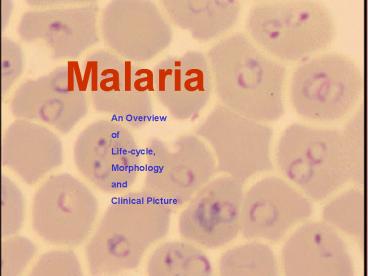Malaria - PowerPoint PPT Presentation
1 / 39
Title:
Malaria
Description:
Malaria An Overview of Life-cycle, Morphology and Clinical Picture Malaria Species Four species of malaria : Plasmodium falciparum: malignant tertian malaria ... – PowerPoint PPT presentation
Number of Views:968
Avg rating:3.0/5.0
Title: Malaria
1
Malaria
An Overview of Life-cycle, Morphology and
Clinical Picture
2
Malaria Species
- Four species of malaria
- Plasmodium falciparum malignant tertian malaria
- Plasmodium vivax benign tertian malaria
- Plasmodium ovale benign tertian malaria
- Plasmodium malariae quartan malaria
3
Estimated incidence malaria episodes(caused by
any species) resulting from local transmission,
country level averages, 2004
4
(No Transcript)
5
LIFE CYCLE OF MALARIA
sporozoites
Pre-erythrocytic (hepatic) cycle
Exo-erythrocytic (hepatic) cycle
6
Components of the Malaria Life Cycle
Sporogonic cycle
Infective Period
Mosquito bites uninfected person
Mosquito Vector
Parasites visible
Human Host
Mosquito bites gametocytemic person
Prepatent Period
Symptom onset
Recovery
Incubation Period
Clinical Illness
7
CLINICAL SIGNS SYMPTOMS
Hot stage
Cold stage
Sweating
8
Plasmodium falciparum
Plasmodium vivax, Plasmodium ovale
Plasmodium malariae\
9
CLINICAL PICTURE
Chronic Disease
Acute Disease
Infection During Pregnancy
Chronic Asymptomatic Infection
Non-severe Acute Febrile disease
Placental Malaria
Cerebral Malaria
Anemia
Low Birth weight
Developmental Disorders Transfusions Death
Increased Infant Mortality
Death
10
Definition
- Severe malaria is defined as symptomatic malaria
in a patient with P. falciparum asexual
parasitaemia with one or more of the following
complications - Cerebral malaria (unrousable coma not
attributable to other causes). - Generalised convulsions (gt 2 episodes within 24
hours) - Severe normocytic anaemia (Htlt15 or Hb lt 5 g/dl)
- Hypoglycaemia (glood glucose lt 2.2 mmol/l or 40
mg/dl ) - Metabolic acidosis with respiratory distress
(arterial pH lt 7.35 or bicarbonate lt 15 mmol/l) - Fluid and electrolyte disturbances
- Acute renal failure (urine lt400 ml/24 h in
adults 12 ml/kg/24 h in children) - Acute pulmonary oedema and adult respiratory
distress syndrome - Abnormal bleeding
- Jaundice
- Haemoglobinuria
- Circulatory collapse, shock, septicaema (algid
malaria) - Hyperparasitaemia (gt10 in non-immune gt20 in
semi-immune)
11
Definition
- Uncomplicated malaria is defined as
- Symptomatic infection with malaria parasitemia
without signs of severity and/or evidence of
vital organ dysfunction.
12
Complications of malaria Cerebral malaria
13
Malarial Paroxysm
cold stage feeling of intense cold vigorous shivering lasts 15-60 minutes hot stage intense heat dry burning skin throbbing headache lasts 2-6 hours sweating stage profuse sweating declining temperature exhausted and weak ? sleep lasts 2-4 hours
14
(No Transcript)
15
(No Transcript)
16
(No Transcript)
17
(No Transcript)
18
(No Transcript)
19
(No Transcript)
20
Complications of malaria Pulmonary oedema
21
Complications of malaria anaemia
Child with severe malaria anaemia and no other
malaria complication
22
Child with severe malaria anaemia in conjunction
with acidosis and respiratory distress
23
Malarial haemoglobinuria
Clinical Picture Patients with
glucose-6-phosphate dehydrogenase (G6PD)
deficiency may develop intravascular haemolysis
and haemoglobinuria precipitated by primaquine
and other oxidant drugs, even in the absence of
malaria. Haemoglobinuria associated with malaria
(blackwater fever) is uncommon and malarial
haemoglobinuria usually presents in adults as
severe disease with anaemia and renal failure.
24
Laboratory diagnosis of malaria
25
Laboratory diagnosis of malaria
Laboratory diagnosis of malaria
26
Laboratory diagnosis of malaria
27
Laboratory diagnosis of malaria
28
Laboratory diagnosis of malaria
29
Laboratory diagnosis of malaria
30
Laboratory diagnosis of malaria
31
Laboratory diagnosis of malaria
32
Features of Plasmodium
Vacuole
Nucleus/chromatin dot
Cytoplasm
Stippling
33
The Malaria Parasite
Three developmental stages seen in blood films
- Trophozoite
2. Schizont
3. Gametocyte
34
Plasmodium falciparum (trophozoite stage)
- Diagnostic Points
- Small, regular, fine to fleshy cytoplasm
- Infected RBCs not enlarged
- Numerous, multiple infection is common
- Ring, comma, marginal or accole forms are seen
often have double chromatin dots - Maurers dots not clearly visible
35
Laboratory diagnosis of malaria
Rapid diagnostic tests detect malaria antigens
36
Rapid diagnostic tests detect malaria antigens
Plastic cassette format of RDT
37
Rapid diagnostic tests detect malaria antigens
38
WHO recommendations on RDT
- WHO recommends parasitological diagnosis of
malaria - with microscopy or, where not available, RDTs,
- in the following circumstances
- to guide malaria case management in areas
- with low to moderate transmission1
- for confirmation of a malaria epidemics
- for monitoring changes of malaria prevalence over
time - for the assessment of patients with suspected
severe malaria - for investigating antimalarial treatment
failures. - 1 In areas of low transmission incidence of
malaria is lower than in areas of intense - transmission most infections are symptomatic and
all age-groups are equally affected.
39
ACTION OF ANTIMALARIAL DRUG IN THE DIFFERENT LIFE
STAGES OF THE MALARIA PARASITE
- Sporontocides
- Primaquine
- Pyrimethamine
- Proguanil
- Tissue Schizontocides
- Primaquine
- Pyrimethamine
- Tetracycline
- Proguanil
Gametocyide Primaquine
- Anti-relapse (P.vivax)
- primaquine
Wellcome Trust (Modified)
- Blood Schizontocides
- Chloroquine
- Sulfadoxine/Pyrimethamine
- Quinine
- Quinidine
- Artemisinins






























